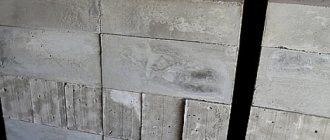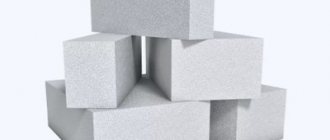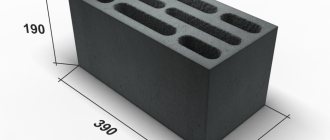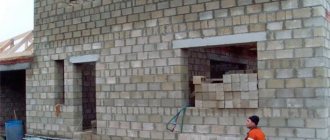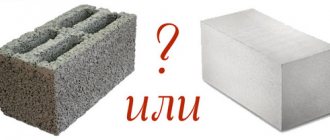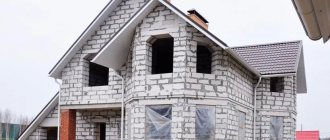Before starting construction of a house, the choice of material for the construction of walls is determined. You should decide in advance which of the materials - expanded clay block or gas block - is better to use for a particular construction. The calculation of the foundation depends on the choice of material, since it must support the weight of the building structure.
Difference in composition
First of all, you should know the production features of each material. The composition of an aerated concrete block includes quartz sand, cement, lime, water, and a little aluminum paste. For better strength, this mixture is processed with hot steam under high pressure.
The composition of expanded clay includes expanded clay and a mixture of cement. Next, the solution is thoroughly mixed and poured into molds, followed by compaction. After the mixture has hardened, the resulting blocks are removed from the molds and sent to dry for a month.
Characteristics of aerated concrete blocks
Aerated concrete blocks are made using autoclave hardening technology. Thoroughly mixed ingredients are fed into a chamber with high humidity. Next, the mixture is treated with steam under pressure. Under such conditions, a chemical process occurs between calcium and aluminum oxides and quartz sand. As a result of this reaction, air pores are formed. That is, it turns out to be a block filled with gas. The mixture hardens naturally.
The production technology allows us to obtain a porous but durable material. The density of aerated concrete blocks can be different. Thermal insulation depends on thickness. It increases with less volume. Sound insulation, on the contrary, increases with high volume density. Its strength is compared to stone, and its porous structure is similar to wood.
Aerated concrete products are considered environmentally friendly. The products do not contain toxic components. Clear parameters and smooth edges of the block create ease of installation.
Which is better for construction? Each type of material is applicable in construction, where its qualities are profitably exploited. Expanded clay concrete blocks are used to construct the building frame. Aerated concrete blocks are used for the construction of internal walls. And both material options are used to build houses.
Block properties
In terms of strength, expanded clay block is superior to aerated concrete. The density of the first is D800-D1200, while the density of aerated concrete block is D400-D600. The strength of expanded clay concrete blocks is 50-150 kg/cm2, and that of aerated concrete blocks is 35-65 kg/cm2.
Hollow expanded clay concrete blocks have a reduced load-bearing capacity. To improve this indicator, the voids should be laid perpendicular to the main supporting side.
High-quality and heavy expanded clay blocks are even used for the construction of multi-storey buildings (12 floors). But aerated concrete is used for the construction of three-story buildings, no higher.
But expanded clay concrete is not suitable for building a base or laying a foundation. It's all about a high humidity environment, to which they do not respond very well.
Characteristics of expanded clay concrete blocks
The most important technical characteristic of expanded clay products is density. Because density provides the following qualities:
- energy saving;
- sound insulation;
- reliability of load-bearing walls
The density of expanded clay concrete blocks depends on the filler fraction. The blocks can be either standard or thick and solid. Service life 60 years or more.
The energy-saving properties and strength of the blocks are ensured subject to:
- if high-quality clay is used to make expanded clay of the required density;
— use of cement grade M500.
Expanded clay concrete structures are durable. Therefore, expanded clay concrete in masonry can withstand heavy weight loads. In addition, buildings:
- resistant to cracking;
- There is no crumbling of the walls.
Expanded clay concrete walls meet fire safety class A1.
Thermal insulation
Which material keeps heat in the house better? The aerated concrete block has decent heat resistance due to its porous structure, inside which air circulates. Expanded clay in the block is known as a good insulating material for insulating attic floors, floors and voids between walls.
The higher the density of the material, the less thermal insulation it has and requires additional insulation.
Based on the above, aerated concrete can be laid in one row without the use of insulation. Expanded clay block retains heat inside by 1/3, which will require the use of extruded polystyrene foam and other thermal insulation materials.
Technical characteristics of foam concrete
The production technology of this building material is so simple that it can be produced directly on the construction site, since it only takes a few hours to completely harden. Equipment for the production of foam concrete can be purchased or simply rented.
The composition of foam concrete includes cement (not lower than grade M400), filler (ordinary sand is often used), water, additives (plasticizer, fiber, hardening accelerators), as well as special foam (foaming agent).
All these components are mixed and poured into prepared forms, where they remain until they completely harden. The cost of producing foam concrete, as well as expanded clay concrete, is quite low.
Features of foam blocks
The main characteristic of foam concrete is its density. The denser the material, the stronger the block made from it will be. Foam concrete combines the properties of wood and stone, namely: reliability and strength, which are characteristic of stone, as well as lightness and the possibility of simple processing, which is so characteristic of wood.
At the same time, it is used in construction not only as a material for structural construction, but also as a reliable insulation material. Buildings made of foam concrete are considered highly comfortable, since this material is able to “breathe”, but at the same time it does not allow street noise to pass through at all. In addition, it is fireproof, durable and at the same time has excellent thermal insulation properties.
And if the choice is a foam block or expanded clay block based on such a parameter as weight, then we note that the first is almost 2.5 times lighter than the second. A standard foam concrete block has dimensions: 600 x 300 x 200.
Vapor permeability
In terms of moisture resistance, these materials have significant differences. Aerated concrete absorbs up to 25% moisture, expanded clay concrete – up to 10%. However, due to the greater weight at the output, the moisture composition will be approximately the same. But the vapor permeability of expanded clay is significantly lower. True, many believe that breathable walls are more environmentally friendly and create a favorable microclimate. But in this case, you should be prepared for additional insulation.
Compound
To understand the difference between a gas block and an expanded clay block, first of all you should consider the production features. Aerated concrete is formed from water, lime, cement, quartz sand with a small addition of aluminum paste. The latter is used to foam the composition. After hardening, briquettes of the correct shape are cut, then the product is exposed to steam and pressure.
The main component of expanded clay concrete is expanded clay diluted with cement. The composition is thoroughly mixed, then poured into molds in which it is compacted. After hardening, the product is removed and dried naturally for a month.
What is stronger: aerated concrete block or expanded clay block?
The reliability and integrity of the finished object are important criteria for the owner, so the wall material must first of all be durable. The comparison of “gas block or expanded clay block” should start with these characteristics.
According to the generally accepted standard, the maximum density of aerated concrete is 1200 kg/m3 (class B12.5), the lowest characteristics for class B 3.5 are 500 kg/m3. The higher the indicator, the greater the load the erected structure can bear. At the same time, the price of building materials increases. It was the economic component that practically excluded blocks with a density of D600 from free sale.
The consumer characteristics of structural expanded clay are determined by the state standard GOST-25820. According to the standard, the minimum strength of the block is 12.5 MPa with a maximum density of 2000 kg/m3. Such parameters are enough to lay a reliable foundation, which is generally allowed by building codes.
Manufacturers produce both special blocks for foundation construction (FBS) and small-format ones - from which the base is laid. It is prohibited to organize a foundation or basement floor from aerated concrete. The point is not only the lower density of the building material, but also the pores through which moisture is absorbed (expanded clay block and aerated concrete block for comparison of hygroscopicity: 25% versus 18% in favor of expanded clay stone).
Aerated concrete, compared to expanded clay concrete, is not as durable. If the structure is being built in a region with high seismicity, it is better to choose the latter. But under standard conditions, especially when choosing a material for floors, high strength is not required; the advantage will be with the porous material. In this case, the thermal conductivity of the gas block and expanded clay block will be more important - the first material has virtually no competitors here. Note: Below brand D500 are building materials for thermal insulation purposes. They are not suitable for masonry, they are used only as insulation.
Dimensions and weight
When comparing the advantages of aerated concrete blocks over expanded clay blocks, the dimensions of the blocks are also taken into account. The standard ratios for a gas block are 200/250/300 and 600/625 mm. The width of briquettes for laying walls is 200-500 mm. The weight of each thermal insulation block varies from 14 to 48 kilograms. Massive blocks often have handles to make working with the material easier.
The dimensions of a common expanded clay concrete block are 190×188×390 mm, some brands reach a width of 230 mm. The average weight of a product suitable for laying walls is 11-17 kg.
Thus, it is difficult to choose between materials. The larger the block, the faster the installation. In this case, problems arise with the delivery of blocks to the laying site, which is important during the construction of buildings where the project includes more than 1 floor.
Thermal conductivity
When comparing which is warmer, expanded clay block or gas block, the porosity of the material comes to the fore. On the one hand, the indicator negatively affects the resistance of the material to compressive loads, on the other hand, it has a positive effect on the thermal insulation parameters.
Thermal conductivity is primarily affected by the density of the building material. For expanded clay blocks the indicator is in the range of 0.4 to 0.8 W/(m*K). Larger values will be for a solid block, smaller values for a product with technological voids.
Aerated concrete has a thermal conductivity, even at maximum density, of no more than 0.14 W/(m*K). Blocks with reduced parameters are characterized by a value of about 0.08 W/(m*K).
As you can see, when determining which is warmer, aerated concrete or expanded clay concrete, the difference is significant. At equal density, the efficiency of aerated concrete is higher than that of expanded clay products. To ensure thermal protection of the facility, a smaller thickness of walls made of aerated blocks is required. In regions where 600 mm thick expanded clay block masonry is required, 500 mm thick gas block walls will be sufficient. Thus, savings are achieved not only in the construction of walls, but also in laying the foundation, which will bear less load.
Frost resistance
There is no favorite in this category. For the construction of housing, as a rule, expanded clay blocks of the F50 brand and a gas block of the F50-100 type are used. The maximum frost resistance coefficient for an aerated concrete block is F100. Expanded clay concrete used for road construction can survive up to 200 freezing cycles.
Fire resistance
Both types of building materials have a low flammability rating. When they are heated, no toxic substances are released. Expanded clay block is able to retain its primary properties when in contact with open fire for up to 3 hours. Aerated concrete has a higher indicator - more than 7 hours.
Hygroscopicity and vapor permeability
Aerated concrete blocks and expanded clay concrete differ radically in moisture resistance. For the first, the absorption coefficient is 25% of the total mass, for the second it is 10%. Considering that a block of expanded clay is heavy, in absolute terms, products of the same size absorb approximately the same volume of water. If the material is over-moistened, its thermal insulation properties are lost, so it is important to carry out exterior finishing, protecting the blocks from negative external factors that can worsen the comfort in the house.
The vapor permeability of aerated concrete is higher than that of expanded clay concrete: 20-23 mg/(m*h*Pa) versus 0.3-0.9 mg/(m*h*Pa). Porous walls that breathe provide a better microclimate in the room, but at the same time require careful selection of thermal insulation materials for external and internal decoration. Based on these facts, the choice is an individual decision, depending on the personal preferences of the customer.
Environmental friendliness
Both building materials are safe for both humans and the environment. The only controversial component included in aerated concrete is aluminum, which is used to foam the mixture. But numerous scientific studies and tests have proven the safety of using such an additive. The concentration of aluminum paste is insignificant and does not pose a threat to human health. Moreover, as a result of a chemical reaction, it breaks down into safe components.
Another risk factor is the dishonesty of the aerated concrete manufacturer. Some companies are experimenting with the composition in order to reduce the cost by adding ash and slag. To exclude the purchase of such blocks, you should place an order only from well-known distributors who can present a quality certificate for each batch of goods.
There are opponents of new technologies, which in particular point to the radioactivity of the material and the production of formaldehyde during the heat treatment of expanded clay and aerated concrete. In fact, aerated concrete is expanded clay that has undergone heat treatment. This is a natural material, if the composition is observed, it does not generate hazardous substances or gases.
Shrinkage
Like other building materials, block walls shrink slightly. For aerated concrete, a subsidence of 0.3 mm/m is considered normal. For expanded clay blocks the parameter is set at 0.4 mm/m. If you follow the established rules, such a slight shrinkage will not affect the interior decoration. If a crack appears on the walls, the reason is probably an incorrect calculation of the loads on the structure or errors when laying the foundation.
Read more about shrinkage of aerated concrete
Fastening and processing
Due to its increased density, expanded clay concrete holds fasteners well. To install hanging cabinets, shelves, decorative elements, and appliances, anchors are not required, as when working with aerated concrete. Accordingly, finishing work is simplified, for example, plasterboard covering.
When choosing a building material, it is important to take into account the processing features. Aerated blocks are easier to cut, grind, drill, groove, and chamfer. To carry out the work, a simple hand tool is sufficient. A grinder is used to process expanded clay blocks.
Environmental friendliness
Sometimes you can hear that cellular concrete contains harmful aluminum. This means that such blocks cannot be safe in any way. In fact, the concentration of this substance is so low that it cannot threaten our health in any way.
When purchasing aerated concrete, it is very important to trust a reliable company. The fact is that low-quality cellular blocks partially contain slag and ash instead of sand. You can avoid this if you take your choice of seller seriously and also check quality certificates.
The difference between expanded clay concrete and aerated concrete
So, what should you choose, gas block or expanded clay block? Judging by the possibility of application, expanded clay blocks are suitable for creating monolithic structures. Aerated concrete products are almost never used in such structures.
Expanded clay concrete blocks are fastened with cement-sand mortar. The thickness of the seam in the masonry should be approximately 10 - 15 mm. Aerated concrete blocks are held together with a special adhesive for cellular concrete. The seam layer is laid out only 2 mm.
For comparison, the cost of aerated concrete blocks is less than expanded clay blocks. However, aerated concrete walls in cold areas should be thicker. It is not always possible to save money by purchasing cheap building materials.
Price
Expanded clay concrete blocks are higher. However, if we take the cost of the box as a whole, then the final amount may be approximately the same. For example, to minimize uneven masonry, more mortar and plaster are used, but at the same time there are no additional costs for the purchase of special anchors. Shipping costs also matter. It will be cheaper to bring aerated blocks to the site, since the final weight of the material per cube will be less.
What is better - expanded clay block or aerated concrete? Each option has its pros and cons. Therefore, you should rely on the budget, number of floors, thermal insulation requirements and other factors.
supplies these materials directly from the manufacturer. We are pleased to offer affordable prices, consultations and assistance in calculations, delivery. Call now!
Advantages and disadvantages
Aerated concrete or expanded clay concrete, which to choose for construction? It is better to make a choice by assessing the advantages and disadvantages of each type.
Expanded clay concrete has undeniable advantages - an affordable price for the material. Its qualities are attractive to the developer:
- frost resistance;
- soundproofing;
- cracks do not appear during shrinkage.
Expanded clay concrete can be used for the construction of load-bearing walls. The walls can support heavy weight. The surface of expanded clay concrete blocks holds a driven nail well, even without devices.
Plaster adheres better to expanded clay concrete walls. But these blocks are distinguished by an uneven surface and curvature of the products, so a lot of mortar is used for finishing. Which entails an increase in costs for finishing work.
The foundation for expanded clay concrete must be reinforced so that the building is strong and reliable. This means that you cannot save on building the foundation.
Only after a careful comparison of expanded clay concrete and aerated concrete blocks of their properties and qualities can the right choice be made.
Description of expanded clay concrete
Expanded clay concrete is one of the varieties of lightweight concrete produced in accordance with GOST 25820*2014. Wall blocks are made from it according to GOST 33126 adopted in the same year (before that the regulation was GOST 6133*99, which is still in effect today).
- The main difference between this type of concrete is the presence of coarse and fine aggregate. Its role is played by expanded clay - a porous lightweight material obtained from intumescent baked clay. It is produced in two variations: in the form of gravel with a fraction of 5-40 mm, and in the form of sand. Both of them are used in the production of expanded clay concrete; it is due to such fillers that the weight and density of products are reduced.
- Only cement is used as a binder here, whereas in the case of aerated concrete it is most often combined with lime. Expanded clay concrete, like cellular concrete, can also be: 1) thermal insulation, 2) thermal insulation-structural, 3) structural.
- Walls can only be erected from blocks belonging to groups 2 and 3. And this is where all the differences between expanded clay concrete blocks and aerated concrete begin. KB can be considered structural and thermal insulating only with a density above 500 kg/cm2, autoclave GB - already from 300 kg/cm2. And since the coefficient of thermal conductivity depends on this, this indicator will be lower for aerated concrete.
- Expanded clay concrete has a wider range of densities: from 200 to 2000 kg/m3 (GB has a maximum of 1200 kg/m3). For the construction of houses, solid blocks of the M100 brand with a density of 1500 kg/m3, and hollow M50 blocks with a density of 950 kg/m3 are most often offered. Their strength, of course, is excellent, but due to their higher density, their thermal conductivity is twice as high as that of structural thermal insulating aerated concrete.
- Since expanded clay concrete has a higher specific gravity, and the products are molded using injection molding technology, the blocks are made in a smaller format. Maximum length 390 mm, height 190 mm. The width of the KBB is only 188 mm, and it does not allow the thickness of the external walls to be formed in one layer.
With a smaller format of masonry material, the complexity of constructing enclosing structures increases. Accordingly, when working with expanded clay block it is higher than that of a wall made of aerated block, which has a greater length (600-625 mm), and width (up to 500 mm), and height (200 or 250 mm).
